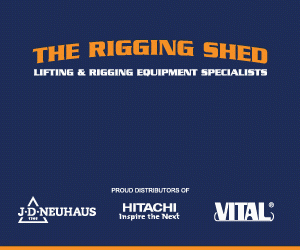)
Safety Starts at Home
Only when everybody takes responsibility for safety can we reduce accidents associated with lifting and rigging equipment. Pre-use inspection is a good place to start.
A single item of rigging gear gets passed through many hands. It is manufactured, shipped, stored, distributed, probably stored again, and then used to connect a hook to a load. By the time it has been used below-the-hook on multiple occasions, many more would have handled it. The trouble is, it creates a ‘someone else’s responsibility’ culture, where it is assumed that another person in the chain made sure it was safe to use. That theory is as dodgy as a weak link in a chain sling—potentially fatal.
You have got to take responsibility for safety, whether you are a manufacturer, reseller, supervisor, user, worker, crane driver, or someone else. Unless every time you look at a piece of equipment or machinery, you ask yourself, “Is it safe?” you are potentially facilitating a dangerous situation.
Wherever we dip into a supply chain, the same attention should be given to safety. Australian business owners are responsible for health and safety in the workplace. They need to ensure that the business doesn’t create health and safety problems for employees, contractors, volunteers, visitors, customers, or the public. This includes ensuring safe use and handling of goods (material handling) and substances, in addition to providing and maintaining safe machinery and materials.
This magazine has a strong readership in the end user marketplaces that use lifting and rigging gear, so I want to focus on what they can do to make sure their entire workforce goes home safely at night—without fail.
Heart count
The importance of inspection is at the heart of this message. Recent updates to standards and legislation have placed even more emphasis on testing and inspection criteria. Many of the standards that are relevant to the lifting equipment marketplace here in Australia are produced by the ME-025 Lifting Tackle committee at Standards Australia—the nation’s peak non-government, not-for-profit standards organisation. ‘AS 3776:2015 Lifting components for Grade T(80) and V(100) chain slings’ is among the standards that reference testing throughout their pages.
Users are often in doubt as to how frequently they should inspect their equipment. Depending on the specific piece of kit in question, we always recommend that the relevant Australian Standard be consulted. For example, it might be ‘AS 3776:2015’ or ‘AS 3775.2:2014 Chain slings for lifting purposes – Grade T(80) and V(100) – Care and use’. Sometimes a tailored inspection policy should also be implemented to suit the requirements of a workplace, making this a complex issue and reiterating the importance of working with expert product and service providers.
Note that ‘AS 3775.2:2014’ says, prior to each use, chain slings shall be visually inspected by a competent person. Pre-use checks are always good practice, regardless of the item of equipment in question and the standard behind it. The inspection shall determine whether slings, for instance, are free of any damage or wear that exceeds the allowable discard criteria and a working load limit (WLL) tag is fitted. If any defects are detected, the sling shall immediately be withdrawn from service and checked.
It is important that the safety starts at home mantra isn’t misinterpreted. It is not meant to imply a blinkered approach should be taken whereby a user feels solely responsible for his or her own wellbeing. It means that they have a responsibility to ensure they are safe by whatever means or support available.
I get asked the question a lot, “Can I do my own lifting gear inspections?” When the costs and risks are weighed up, there is little incentive for a company to conduct their own mandatory inspections. Lifting equipment inspection should be overseen by professionals who are repeatedly trained and tested and who are experts in their specialist field.
Bifocal approach
A good combination is to adopt in-service and periodic inspections. A Lifting Equipment Engineers Association (LEEA)-trained lifting equipment expert can conduct training and refresher courses so customers can inspect their kit before each use, while the experts can come in periodically.
For reference, in-service inspection is a visual procedure to be carried out before each use of the equipment. Periodic inspection is more comprehensive and might involve the removal of equipment from a place of work to a location where it can be properly cleaned, analysed and the results documented. Note that synthetic rigging gear will generally have a shorter inspection frequency than chain or wire rope, but standards do cite exceptions where equipment is in intensive use.
As a cautionary word, if a company decides to inspect its own equipment, they may not be covered by insurance policies if the insurer is not notified. In many cases, professional indemnity cover doesn’t exist either. Getting the proper insurances in place to cover in-house inspection can be expensive and outweigh any perceived saving versus outsourcing. There is also the time factor to consider as care and attention needs to be given to all lifting equipment inspection.
Any level of outsourcing shouldn’t be treated as giving responsibility away to a third party. Safety is never only someone else’s responsibility. I’ve seen some rigging gear brought back to me on the back of a ute and the user has said, “I need a new tag, mate.” Never mind a tag, the hooks have been bent and the chain stretched. In these cases, the equipment needs immediate marking for discard and removal from site. Further, the individual needs to be made aware that the item they were returning for re-tagging could have stopped them or a colleague ever going home again if it were applied below-the-hook.
As an aside, Australian Standards make frequent references to competence and competent persons. In fact, competency is complicated because there’s room for subjectivity. In other words, what’s competency to one person isn’t necessarily to the other. I prefer to use LEEA training as the barometer by which to measure knowledge and best practices.
User’s guide
If you are a user taking delivery of equipment, it’s a good idea to ask the supplier for a user’s guide. Such guidance should make the user aware that while the equipment might only be a necessary tool that supports their work, the lifting equipment sector is a regulated industry in its own right. Slings, harnesses, shackles, etc. are not like paint brushes. It takes a great deal of expertise, skill, and knowledge to safely work in proximity to a load or a crane and due care must always be taken. We’re always going to encounter those who don’t pay attention, however. How often do you see misuse of the simplest of tools, like ladders, jacks, and handsaws? Every day, I bet. We’ve got to keep eroding that mentality.
It’s evident that responsibility of ownership is a key criterion of safety. If equipment is not inspected properly and thoroughly, the ramifications could be costly and even lead to fatality. Despite the consequences, lifting equipment inspection can often be overlooked or seen as an unnecessary cost to a project, especially when budgets are tight. In some cases, a user might feel that the costs outweigh the perceived benefits, but that mindset can typically be attributed to poor service or a lack of understanding about the importance of inspection.
If you implement one thing at your facility after reading this article, make it inspection before each use of equipment. It’s a best practice that should be taken seriously so even a small defect can be investigated in advance of work commencing. Look for anything that is abnormal or out of place. Excessive pitting, weld splatter, wear, and gouges are all common signs that rigging gear might not be safe to use. If an issue isn’t immediately apparent and it presents itself whilst in operation, stop immediately and locate the cause of the problem. It might be that a chain is seizing or a hoist isn’t operating as smoothly as the previous day. Regardless of how small the issue might seem, don’t ignore it and allow the problem to become worse.
As I wrote in my introductory message last time, this is as much your column as it is mine. I have a notebook full of ideas about subjects to explore but I’m happy to look into matters from industry. Email me and we can open dialogue: ashley@ranger.com.au









